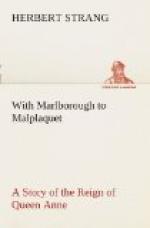The Queen was in a very bad state of health; she might die any day. But the Electress Sophia died first, and her son, Prince George of Hanover, became the next heir to the throne, a prospect not much to the liking of many in England. Some of the leading Tories were making preparations for a revolution in favour of the Pretender, but the death of Anne came before their preparations were complete, and George of Hanover was quietly proclaimed as George I.
Before Marlborough died George Fairburn was a lieutenant-colonel, and, as he happened to be stationed for a time at Windsor, he and his wife, the Mary Blackett of old, had more than once the honour of an invitation to Windsor Park, the Duke’s favourite abode, his great palace of Blenheim being not yet ready for him.
* * * * *
We hear of our hero, many long years after all this, a stout old soldier, General Sir George Fairburn, taking part in the memorable chase after the Young Pretender in 1745, and the subsequent great fight at Culloden.
“And I tell you, sir,” said Mr. Matthew Blackett, member for Langkirk, as he told the story to a crony in the smoking-room of his club, White’s, “I tell you, sir, he trod Culloden Moor with all the vigour and fire he had when we marched with Marlborough to Malplaquet.”
REIGN OF QUEEN ANNE
IMPORTANT QUESTIONS AND MOVEMENTS
1. THE SUCCESSION TO THE CROWN
This question, especially after the death of all Anne’s children, became a most important one. The Whigs and the country in general were bent upon securing a Protestant succession, but there were some, especially amongst the Tories, who were secret supporters of the Pretender, James Stuart, son of James II. The Act of Settlement had provided for the accession of Sophia as the nearest Protestant descendant of James I, on the failure of Anne’s issue. At one time the Scotch Parliament threatened to elect as king a different sovereign from that of England, unless Scotland should be given the same commercial privileges as England possessed. The Act of Security, passed in 1704, declared as much. Both Bolingbroke and Harley were in correspondence with the Pretender, and it was only through the death of the Queen earlier than had been expected that a revolution in favour of the exiled Stuarts was averted.
2. GOVERNMENT BY PARTY
Until the reign of Anne what we now call Party Government was unknown. We may see the beginnings of the division of politicians into Whig and Tory in the Roundhead and Cavalier factions in the reign of Charles I. Government by the one strong man of the time—a Burleigh, a Cromwell, a Marlborough—was the usual thing. Marlborough was the last who tried to govern without party. During the reign of Anne the Whigs and Tories were combined in varying proportions, till the final return of a Tory House of Commons and the formation of a purely Tory ministry, in 1711. From that time Party Government, as we now understand it, has generally prevailed.




